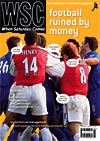 York City chairman Douglas Craig has put the club up for sale after announcing losses of £1.2million. Paul Fenton looks into the situation at Bootham Crescent and the task any prospective buyers will be taking on
York City chairman Douglas Craig has put the club up for sale after announcing losses of £1.2million. Paul Fenton looks into the situation at Bootham Crescent and the task any prospective buyers will be taking on
Douglas Craig, chairman of York City, has had little cause to bother fans outside the city during a decade in charge, apart from deciding that York were the only club above signing the anti-racism Kick It Out charter. City fans, however, had tired of being told by the ex-councillor (Tory, since you ask) to stay away if they disagreed with his methods, and being threatened with the closure of the club if there were any more protests against him.
But on December 20 he announced that the club was up for sale – losses of £1.2 million in the previous year meant it would run out of money by the end of February, and was averaging a weekly deficit of £24,000. The club gave provisional notice that it would resign from the League on April 1 if no buyer was found.
The news was greeted with a nervous optimism by fans dreaming of a future free from a man who once sent a bill for the costs of sweeping the terraces to the organisers of a red card protest. But they had reckoned without the “business expertise” of the board. In July 1999 they set up a company, Bootham Crescent Holdings, to which they transferred the main asset of the club, the ground itself. Shareholders in the football club were reassured that the “corporate restructuring” was intended to safeguard the assets of the club. In any case, the directors owned 94 per cent of the shares, so approval for the move was a formality. The price was £165,000.
The bombshell came with the news that BCH had given the club notice to quit the ground by June. City could be bought for next to nothing, but the ground the club had owned for 70 years until 1999 was an optional extra, at £4.5 million. They kindly offered to contribute £1 million towards clearing the debts and upgrading York rugby league club’s tiny Huntingdon Stadium to League status.
The best guess is that the football ground, built mainly with money raised by fans and with a stand named after David Longhurst, the striker who collapsed and died during a game against Lincoln in 1990, will then be bulldozed for housing, and 94 per cent of the proceeds will go to the current directors of the football club, who paid a total of £200,000 for their stake. Previous directors have never attempted to profit from their shareholdings.
You get a hint that a man is not fit to run a club when he marches out of a transfer tribunal when things aren’t going his way. Confirmation arrives with the news that the wage bill for a struggling side has tripled in six years, and now stands at 180 per cent of gate receipts – the division’s average is 70 per cent. The sales of Graham Murty, Richard Cresswell and Jonathan Greening for almost £3 million have kept the club going, but it seems the legacy of these (for us) great players has been thrown away. A cynic might even speculate that the club had been deliberately run down.
But an optimist might look at the formation of a Supporters Trust to get representation on the board as a step forward. Perhaps Gordon Gibb, owner of nearby theme park Flamingoland will bid again for the club – his previous offer in August 2000 which would have made £1 million available for new players was turned down, for now obvious reasons. Groundsharing offers have come from Scarborough and Chesterfield (whom Craig tried to get thrown out of the League last season). A Fans United day is planned, and Mohammed Al Fayed has promised the Supporters Trust Fulham’s share of the receipts from the FA Cup game – he originally offered the money to the club, but was turned down by Craig.
Even the Evening Press – in a tricky position as the club’s sponsor – has spoken about fans being sold down the river. Perhaps the saddest thing is the presence on the board of ex-player Barry Swallow, voted City’s Millennium Hero. It seems you can’t trust anyone these days.
From WSC 181 March 2002. What was happening this month